A historic observatory in New England could be a stone remnant on the Canadian border, a mountaintop clubhouse or a state-of-the-art, NASA-funded astronomy compound at Harvard University.
Astronomy has been important to the United States since it was founded. The new country lacked accurate maps, a vexing problem for mariners and military planners. Astronomical observations established latitude and longitude – and hence good maps – in the early 19th century.
In New England, astronomy has always been open to talented amateurs. Though most stargazing takes place on university campuses with equipment from wealthy donors or the government,…
Amateur stargazers have plenty of opportunities to watch the partial solar eclipse on Aug. 21, 2017. Some are at or near the historic observatories described below. If you know of another historic observatory in New England, please mention it in the comments section.
Leitner Family Observatory
Over the centuries Yale’s role in astronomy has teetered from leadership to also-ran. In 1807, Yale professor Benjamin Silliman founded meteorite science when he determined the Weston Meteorite was a rock that fell from space.
Yale established its first observatory in 1830, when Sheldon Clark donated the largest refractor in the United States. For the next decade, Yale was the country’s top institution for astronomy. In 1835, for example, the first American sighting of Halley’s Comet was made from the Yale observatory.
Yale fell behind in astronomy by the 1850s, but in the late 19th century William Elkin further advanced meteor science by accurately measuring the speed of meteors from the observatory. The building was demolished in 1893.
A new observatory, the Loomis Tower, was built in 1923 and named for Yale mathematician Elias Loomis. It had the largest polar telescope in America, but the telescope was moved to Bethany, Conn., in 1957. In 2008 the Yale observatory was renamed the Leitner Family Observatory, presumably after a gift from Austrian billionaire Wolfgang Leitner.
The observatory hosts a planetarium show every Tuesday evening. Afterward, its telescopes are open for viewing planets, star clusters and nebulae. It will also be open at 1 pm on Aug. 21 for viewing the partial solar eclipse.
355 Prospect St., New Haven, Conn.
Calais Observatory
All that remains of the Calais Observatory in Calais, Maine are two granite stones upon which scientific equipment was mounted more than 150 years ago.
The historic observatory dates to the mid-1800s and was in ruin by the late 1890s. Located in Meridian Park, on the grounds of the former Calais Academy, the observatory played an important role in putting Calais on the map – literally. The United States undertook a coast survey in 1830 to map and establish precise longitude and latitude coordinates for locations throughout the country. The Calais Observatory was built as part of that effort.
Visitors today will know it only by the two stone pillars that remain and a NOAA plaque commemorating its historic significance.
North and Lincoln Streets, Calais, Maine
Maria Mitchell Observatories
Maria Mitchell discovered a comet from a rooftop in Nantucket in 1847 and became the first woman astronomer in the United States. She went on to found the astronomy department at Vassar College. After her death in 1889, her niece, Lydia Hinchman, wanted to continue her legacy. She founded the Maria Mitchell Association, which in 1908 built an historic observatory on Vestal Street in Nantucket to house the 5-inch telescope given to Mitchell in 1859.
Hinchman wanted the observatory to do real astronomy as well as educate the public. She consulted a professor from Harvard, preeminent in astronomy since Samuel Williams went behind British lines to watch a solar eclipse in 1780. Hinchman was advised to install a photographic telescope and hire an astronomer to specialize in photographing asteroids with variable brightness. The professor’s assistant, Margaret Harwood, was chosen for the job, which she kept for 45 years. Harwood analyzed 419 variable stars in the Milky Way over 50 years, published a catalogue of 74 asteroids and discovered an unusual variable star called DF Cygni.
A second observatory, Loines, was built in 1968 and 1998. Its two domes house a refurbished antique 8-inch Clark telescope and a new 24-inch research telescope.
The observatory offers summer internships for undergraduates and many educational programs for the public, including a solar eclipse party on Aug. 21, 2017.
Maria Mitchell observatories, 3 Vestal St. and 59 Milk St., Nantucket, Mass.
Shattuck Observatory
The Shattuck Observatory, part of Dartmouth College, traces its roots to 1854 when it was constructed with funds from the college and Dr. George G. Shattuck, Class of 1803.
The historic observatory is the oldest science building on the college’s campus. The observatory’s most famous director was astronomer Edwin Brant Frost, who became a pioneering physics researcher.
Today the observatory is relatively simple compared to state-of-the art telescopes, but it is still used for instruction. Part of the facility, which is located on Observatory Road, is opened for public viewing on Friday nights during the college’s summer term.
The historic observatory will not be the site of public eclipse viewing at the college. Students and members of the public are invited to the college Green from 1:15 to 4 p.m. on August 21 to take part in an eclipse viewing gathering. The physics department will have safe telescopes and eclipse-viewing glasses to share.
15 Observatory Rd., Hanover, N.H.
Ladd Observatory
Self-taught astronomer Benjamin West observed the transit of Venus on June 3, 1769 at Brown (then Rhode Island College), long before the Ladd observatory opened in 1891. West’s observation gained international attention and won him honorary degrees from Harvard and Brown.
Planetary transits became the specialty of the Ladd Observatory, named for Rhode Island’s two-term governor, Herbert Ladd, who donated the money for the building.
It also sent out time signals, but discovered in 1973 that no one was listening so it ended the practice.
The historic observatory was originally located at the highest point in Providence, known as Tin-Top Hill (supposedly because it was a dumping ground for tin cans). Then the border of Providence changed, so it’s now on the second highest point in the city.
H.P. Lovecraft had access to the observatory between 1906 and 1918 and wrote astronomy articles for Providence newspapers about his studies there.
Today, the Ladd Observatory is a museum listed on the National Register of Historical Places. It is closed in August 2017, but will be reopened to the public on Tuesdays from 8-10 pm, weather permitting, beginning Aug. 29, 2017.
To watch the partial solar eclipse on Aug. 21, there will be portable solar telescopes beginning at 1 pm on the Brown University Main Green, weather permitting.
210 Doyle Ave., Providence, R.I.
Stellafane

A large trailer mounted newtonian reflector on display during the Stellafane Convention with the Stellafane “pink clubhouse” and the Porter Turret Telescope in the background.
Stellafane, Latin for shrine to the stars, is a hot-pink clubhouse on the summit of Breezy Hill in Springfield, Vt. It was built by amateur telescope makers in the early 1920s. A local hardware store owner was said to have donated the hot-pink paint.
Since 1926, amateur astronomers and telescope makers gather for the Stellafane Convention on the property, now a National Historic Landmark. Today it is the longest running astronomical convention in the world, attracting thousands of amateur telescope markers from all over the world. The convention is usually held over the weekend of the new moon closest to the height of the Perseid meteor shower. In 2017, it was held a month early because so many attendees were heading south and west to watch the total solar eclipse.
Stellafane started on Aug. 12, 1920, when artist and explorer Russell Porter held a class on how to make telescopes. Porter worked for a machine company nearby; of the 14 men who attended, most worked for the company. The lone woman was a schoolteacher. Porter taught the class how to make Newtonian telescopes, and they decided to form a club.
An asteroid has been named after Stellafane, and craters on the moon and Mars after Porter, who helped build the Hale Telescope at Palomar Observatory, then the world’s largest.
Jordan Road, Springfield, Vt.
Images: Leitner Family Observatory By Daderot. – Own work, CC BY-SA 3.0, https://commons.wikimedia.org/w/index.php?curid=1853907; Loines Observatory By Versageek – Own work, CC BY-SA 3.0, https://commons.wikimedia.org/w/index.php?curid=4793051; Calais Observatory By Magicpiano – Own work, CC BY-SA 3.0, https://commons.wikimedia.org/w/index.php?curid=28026705; Ladd Observatory By Michael L. Umbricht / Ladd Observatory, CC BY-SA 3.0, https://commons.wikimedia.org/w/index.php?curid=45898837; Stellafane By Halfblue at the English language Wikipedia, CC BY-SA 3.0, https://commons.wikimedia.org/w/index.php?curid=6992595
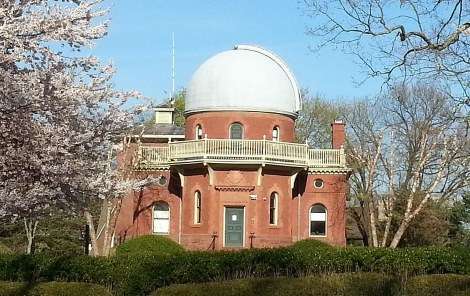
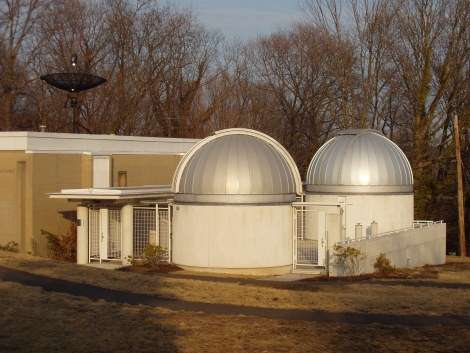
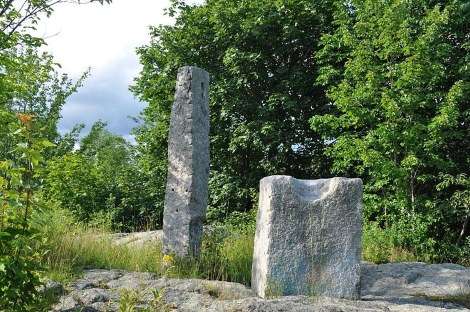
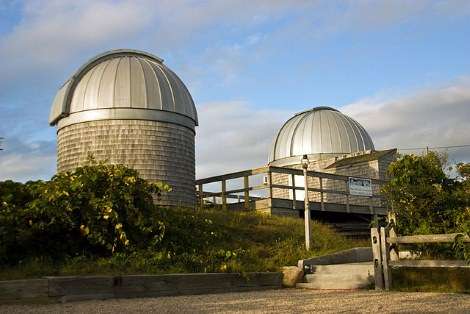
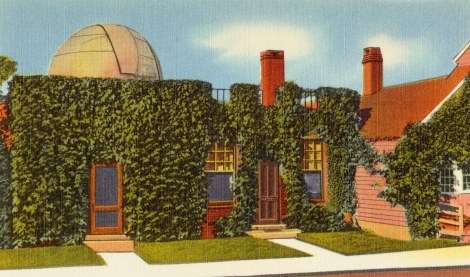
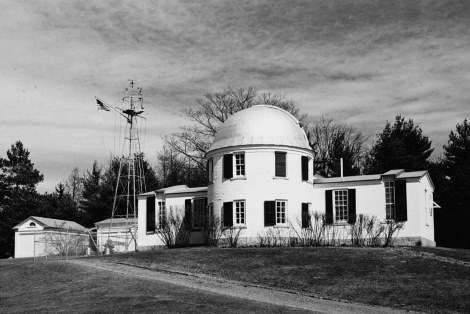
2 comments
You forgot Hopkins Observatory at Williams College in Williamstown MA. It’s the oldest existing astronomical observatory in the United States.
https://astronomy.williams.edu/hopkins-observatory/
Hi,
I am looking for history and pictures of an old watch house (observatory) that used to be in Brandon, Vermont. It was the Mount Pleasant Observatory off Prospect st. I last went to it in the early 1970’s. Any help would be greatly appreciated.
Aimee
Comments are closed.